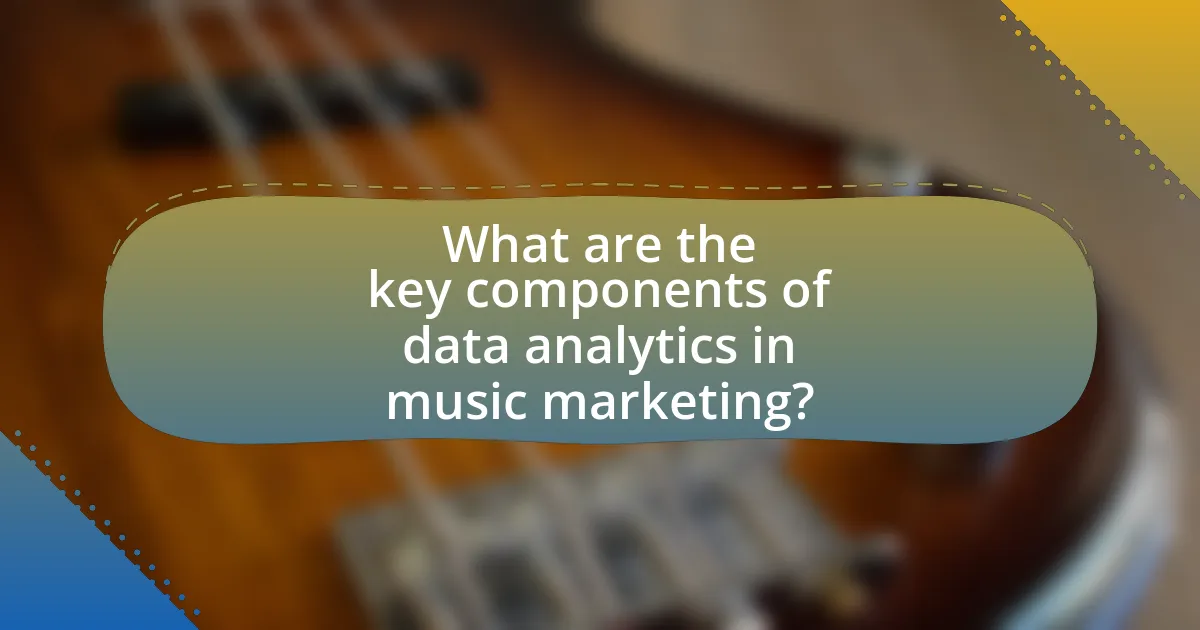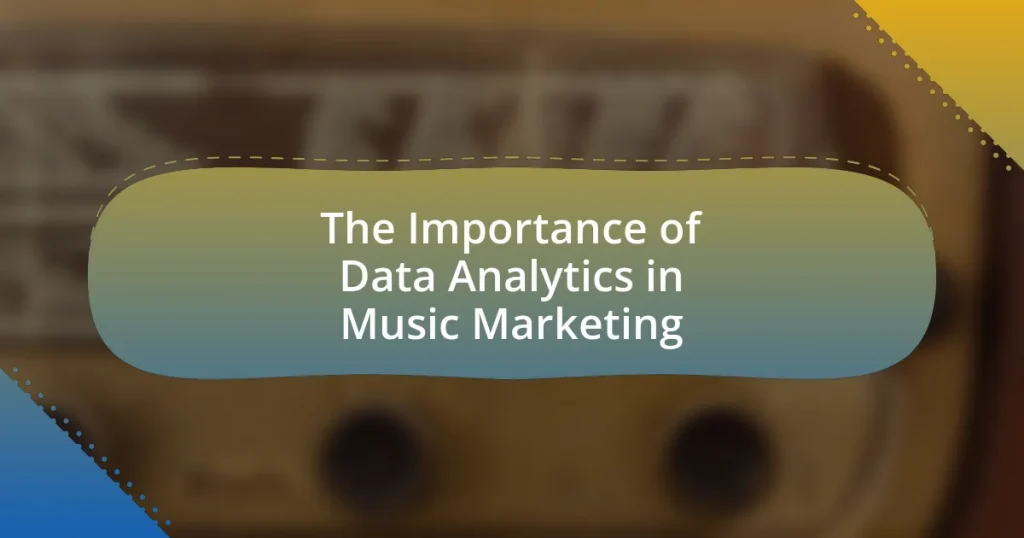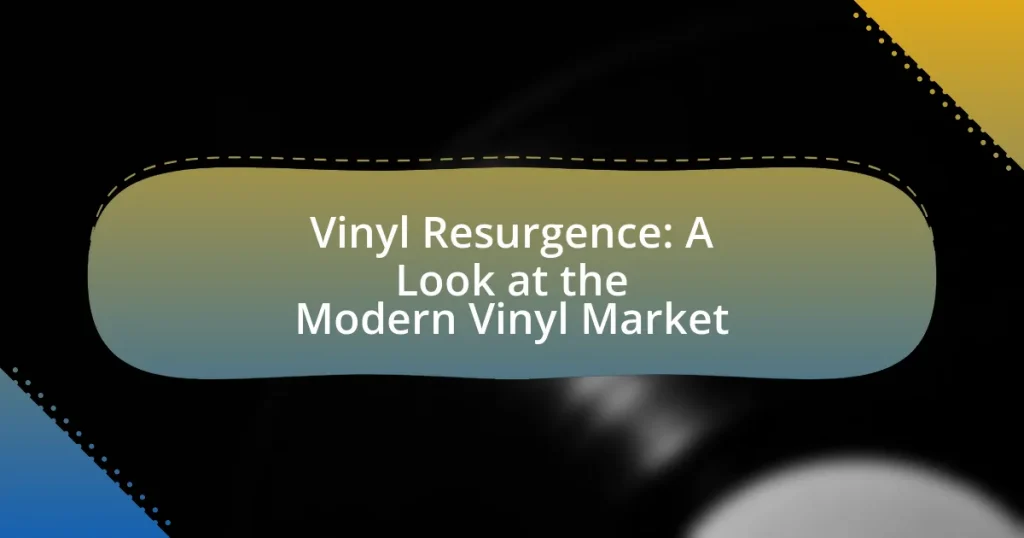Data analytics plays a vital role in music marketing by enabling artists and labels to understand audience preferences and behaviors through the analysis of streaming data, social media interactions, and sales figures. This article explores how data-driven strategies enhance targeted audience engagement, optimize marketing budgets, and improve campaign effectiveness, with key metrics such as streaming numbers and social media engagement being analyzed. It also discusses the importance of data-driven decision-making, the advantages of analytics over traditional marketing methods, and the tools and technologies that facilitate data collection and processing. Additionally, the article addresses challenges marketers face in data analytics and highlights future trends, including the impact of artificial intelligence and emerging technologies on music marketing strategies.

What is the Importance of Data Analytics in Music Marketing?
Data analytics is crucial in music marketing as it enables artists and labels to understand audience preferences and behaviors. By analyzing streaming data, social media interactions, and sales figures, music marketers can tailor their strategies to target specific demographics effectively. For instance, a report by Nielsen Music indicates that data-driven marketing strategies can increase engagement by up to 30%, demonstrating the tangible benefits of leveraging analytics in promotional efforts. This targeted approach not only enhances fan engagement but also optimizes marketing budgets, ensuring resources are allocated to the most effective channels.
How does data analytics influence music marketing strategies?
Data analytics significantly influences music marketing strategies by enabling targeted audience engagement and optimizing promotional efforts. By analyzing listener data, such as streaming habits and demographic information, music marketers can tailor campaigns to specific audience segments, increasing the likelihood of successful outreach. For instance, platforms like Spotify and Apple Music provide detailed analytics that reveal listener preferences and behaviors, allowing marketers to create personalized marketing strategies that resonate with potential fans. This data-driven approach has been shown to enhance conversion rates, as evidenced by a 2021 report from the International Federation of the Phonographic Industry, which indicated that targeted marketing efforts based on data analytics led to a 30% increase in fan engagement for artists.
What key metrics are analyzed in music marketing?
Key metrics analyzed in music marketing include streaming numbers, social media engagement, audience demographics, and sales figures. Streaming numbers provide insights into how often a track is played across platforms, indicating popularity and reach. Social media engagement metrics, such as likes, shares, and comments, reflect audience interaction and brand loyalty. Audience demographics help identify the target market, allowing for tailored marketing strategies. Sales figures, including digital downloads and merchandise sales, quantify financial success and consumer interest. These metrics collectively inform marketing strategies and campaign effectiveness in the music industry.
How do these metrics impact marketing decisions?
Metrics significantly impact marketing decisions by providing quantifiable insights into consumer behavior and campaign effectiveness. For instance, metrics such as engagement rates, conversion rates, and return on investment (ROI) enable marketers to assess which strategies resonate with their target audience. According to a study by McKinsey & Company, companies that leverage data analytics in their marketing strategies can increase their marketing ROI by 15-20%. This data-driven approach allows marketers to optimize their campaigns, allocate budgets more effectively, and tailor content to meet audience preferences, ultimately leading to improved performance and higher sales.
Why is data-driven decision-making crucial in the music industry?
Data-driven decision-making is crucial in the music industry because it enables artists and labels to make informed choices that enhance marketing effectiveness and audience engagement. By analyzing streaming data, sales figures, and social media metrics, industry stakeholders can identify trends, understand listener preferences, and optimize promotional strategies. For instance, a report by Nielsen Music indicates that data analytics can increase the effectiveness of marketing campaigns by up to 30%, demonstrating the tangible benefits of leveraging data in decision-making processes.
What advantages does data analytics provide over traditional marketing methods?
Data analytics provides significant advantages over traditional marketing methods by enabling targeted strategies based on consumer behavior insights. Unlike traditional methods that often rely on broad demographics and assumptions, data analytics utilizes real-time data to identify specific audience segments, preferences, and trends. For instance, a study by McKinsey & Company found that companies leveraging data analytics can increase their marketing ROI by 15-20% through more effective targeting and personalization. This precision allows marketers to optimize campaigns, allocate resources efficiently, and ultimately enhance customer engagement and conversion rates.
How can data analytics enhance audience targeting?
Data analytics enhances audience targeting by enabling marketers to identify and segment specific listener demographics based on behavior and preferences. By analyzing data from streaming platforms, social media, and purchase history, marketers can create detailed profiles of their audience, allowing for tailored marketing strategies. For instance, a study by Nielsen Music found that targeted marketing campaigns based on listener data can increase engagement rates by up to 30%. This precise targeting not only improves the effectiveness of marketing efforts but also optimizes resource allocation, ensuring that promotional activities reach the most relevant audiences.

What are the key components of data analytics in music marketing?
The key components of data analytics in music marketing include audience segmentation, performance tracking, and campaign optimization. Audience segmentation allows marketers to categorize listeners based on demographics, behaviors, and preferences, enabling targeted marketing strategies. Performance tracking involves analyzing metrics such as streaming numbers, social media engagement, and sales data to assess the effectiveness of marketing efforts. Campaign optimization utilizes insights gained from data analysis to refine marketing strategies, ensuring resources are allocated efficiently for maximum impact. These components collectively enhance decision-making and improve the overall effectiveness of music marketing initiatives.
What tools and technologies are commonly used in music data analytics?
Commonly used tools and technologies in music data analytics include platforms like Spotify for Artists, Soundcharts, and Next Big Sound. These tools enable artists and marketers to analyze streaming data, audience demographics, and engagement metrics. For instance, Spotify for Artists provides insights into listener behavior and geographic distribution, while Soundcharts aggregates data from various platforms to track trends and performance. Next Big Sound offers predictive analytics to forecast future performance based on historical data. These technologies are essential for making data-driven decisions in music marketing, enhancing promotional strategies, and optimizing audience reach.
How do these tools collect and process data?
Data analytics tools in music marketing collect and process data through various methods, including web scraping, API integration, and user interaction tracking. These tools gather data from multiple sources such as social media platforms, streaming services, and music sales databases. For instance, APIs from platforms like Spotify and Apple Music provide access to user listening habits and demographic information, allowing for real-time data collection. Additionally, web scraping techniques can extract data from websites and forums where music discussions occur, enriching the dataset. The processing of this data involves cleaning, analyzing, and visualizing it to derive actionable insights, often using machine learning algorithms to identify trends and patterns in listener behavior. This systematic approach enables marketers to tailor their strategies effectively, enhancing audience engagement and optimizing promotional efforts.
What role does social media play in data collection?
Social media serves as a critical tool for data collection by providing vast amounts of user-generated content and engagement metrics. Platforms like Facebook, Twitter, and Instagram allow marketers to gather insights on audience preferences, behaviors, and demographics through interactions such as likes, shares, and comments. For instance, a study by Pew Research Center indicates that 69% of adults in the U.S. use social media, making it a rich source for understanding consumer trends and sentiments. This data enables music marketers to tailor their strategies, optimize campaigns, and enhance audience targeting, ultimately driving more effective marketing efforts in the music industry.
What types of data are most valuable for music marketers?
The most valuable types of data for music marketers include audience demographics, streaming analytics, social media engagement metrics, and sales data. Audience demographics provide insights into the age, gender, and location of listeners, enabling targeted marketing strategies. Streaming analytics reveal listening habits, such as play counts and skip rates, which help marketers understand song performance and audience preferences. Social media engagement metrics, including likes, shares, and comments, indicate fan interaction and brand loyalty, guiding promotional efforts. Sales data, encompassing digital downloads and merchandise purchases, offers a clear picture of revenue generation and market demand. Collectively, these data types empower music marketers to make informed decisions and optimize their campaigns effectively.
How can streaming data inform marketing strategies?
Streaming data can inform marketing strategies by providing real-time insights into listener behavior and preferences. This data allows marketers to tailor campaigns based on current trends, such as identifying popular songs or genres, which can lead to more effective targeting and engagement. For instance, a study by Nielsen Music found that 75% of music listeners are influenced by streaming data when discovering new artists, demonstrating the direct impact of this data on consumer behavior. By analyzing streaming metrics, marketers can optimize promotional efforts, enhance audience segmentation, and ultimately drive higher conversion rates.
What insights can be gained from fan engagement metrics?
Fan engagement metrics provide insights into audience preferences, behaviors, and overall engagement levels with music content. By analyzing metrics such as likes, shares, comments, and streaming statistics, marketers can identify which songs or artists resonate most with fans, allowing for targeted marketing strategies. For instance, a study by Nielsen Music found that 70% of fans are more likely to engage with artists who actively interact with them on social media, highlighting the importance of direct communication in building loyalty. Additionally, tracking engagement over time can reveal trends in fan interests, enabling artists and marketers to adapt their strategies to maintain relevance and connection with their audience.

How can music marketers effectively utilize data analytics?
Music marketers can effectively utilize data analytics by leveraging audience insights to tailor marketing strategies. By analyzing streaming data, social media engagement, and demographic information, marketers can identify trends and preferences that inform targeted campaigns. For instance, a study by Nielsen Music found that 70% of listeners prefer personalized music recommendations, highlighting the importance of data-driven approaches in enhancing listener engagement and driving sales. Additionally, using analytics tools allows marketers to measure campaign performance in real-time, enabling them to adjust strategies based on what resonates most with their audience.
What best practices should be followed when implementing data analytics?
When implementing data analytics, organizations should prioritize data quality, establish clear objectives, and ensure cross-functional collaboration. High-quality data is essential as it directly impacts the accuracy of insights; according to a study by IBM, poor data quality costs organizations an average of $15 million annually. Setting clear objectives helps to align analytics efforts with business goals, ensuring that the insights generated are actionable and relevant. Additionally, fostering collaboration among departments, such as marketing and sales, enhances the effectiveness of data analytics by integrating diverse perspectives and expertise, leading to more comprehensive strategies.
How can marketers ensure data accuracy and reliability?
Marketers can ensure data accuracy and reliability by implementing robust data validation processes and utilizing reliable data sources. Data validation involves checking for errors, inconsistencies, and completeness in the data collected, which can be achieved through automated tools and manual reviews. Utilizing reliable data sources, such as established market research firms or verified customer databases, further enhances the credibility of the data. According to a study by Gartner, organizations that prioritize data quality see a 20% increase in operational efficiency, underscoring the importance of accurate data in decision-making processes.
What strategies can be employed to interpret data effectively?
To interpret data effectively, one can employ strategies such as data visualization, statistical analysis, and contextual understanding. Data visualization, through tools like charts and graphs, allows for quick comprehension of trends and patterns, making complex data more accessible. Statistical analysis, including techniques like regression and correlation, helps in identifying relationships and predicting outcomes based on historical data. Contextual understanding involves considering the broader environment in which the data exists, such as market trends and consumer behavior, to derive meaningful insights. These strategies are validated by research indicating that effective data interpretation can lead to improved decision-making and enhanced marketing strategies in the music industry, as evidenced by case studies showing increased engagement and sales through targeted campaigns based on data insights.
What common challenges do marketers face with data analytics?
Marketers commonly face challenges such as data integration, data quality, and interpreting complex data sets in data analytics. Data integration issues arise when marketers struggle to consolidate information from various sources, leading to fragmented insights. Data quality challenges occur when the data collected is inaccurate or incomplete, which can skew analysis and decision-making. Additionally, interpreting complex data sets requires advanced analytical skills, and many marketers lack the necessary expertise, making it difficult to derive actionable insights. According to a 2021 report by Deloitte, 63% of marketers cited data integration as a significant barrier to effective analytics, highlighting the prevalence of these challenges in the industry.
How can data privacy concerns impact music marketing efforts?
Data privacy concerns can significantly hinder music marketing efforts by limiting the collection and use of consumer data. When consumers are wary of how their personal information is handled, they may opt out of sharing data, which restricts marketers’ ability to create targeted campaigns. For instance, the implementation of regulations like the General Data Protection Regulation (GDPR) in Europe has led to stricter consent requirements, resulting in reduced access to valuable audience insights. This limitation can decrease the effectiveness of marketing strategies, as brands may struggle to reach their desired demographics or personalize their messaging, ultimately impacting sales and engagement.
What solutions exist for overcoming data analysis obstacles?
Solutions for overcoming data analysis obstacles include implementing advanced analytics tools, enhancing data quality, and fostering a data-driven culture within organizations. Advanced analytics tools, such as machine learning algorithms and data visualization software, enable more efficient processing and interpretation of large datasets, which is crucial in music marketing for understanding audience preferences. Enhancing data quality involves regular data cleaning and validation processes to ensure accuracy, which is essential for making informed marketing decisions. Additionally, fostering a data-driven culture encourages collaboration among teams and promotes the use of data in strategic planning, leading to better insights and outcomes in music marketing campaigns.
What are the future trends in data analytics for music marketing?
Future trends in data analytics for music marketing include the increased use of artificial intelligence and machine learning to analyze listener behavior and preferences. These technologies enable marketers to create highly personalized campaigns, optimizing engagement and conversion rates. For instance, platforms like Spotify utilize advanced algorithms to recommend music based on user data, demonstrating the effectiveness of data-driven strategies. Additionally, the integration of social media analytics will allow for real-time insights into audience sentiment and trends, further enhancing targeted marketing efforts. As the music industry continues to evolve, leveraging big data will become essential for artists and labels to stay competitive and effectively reach their audiences.
How is artificial intelligence shaping data analytics in the music industry?
Artificial intelligence is transforming data analytics in the music industry by enabling more precise audience targeting and personalized marketing strategies. AI algorithms analyze vast amounts of listener data, including streaming habits and social media interactions, to identify trends and preferences. For instance, platforms like Spotify utilize machine learning to recommend songs based on user behavior, which enhances user engagement and retention. Additionally, AI-driven analytics tools can predict which songs are likely to become hits by examining historical data and current market trends, allowing record labels to make informed decisions about promotions and artist development. This data-driven approach has been shown to increase the effectiveness of marketing campaigns, as evidenced by a 2021 report from the International Federation of the Phonographic Industry, which highlighted that data analytics significantly boosts revenue generation in the music sector.
What emerging technologies should marketers be aware of?
Marketers should be aware of artificial intelligence, machine learning, augmented reality, and blockchain technology. Artificial intelligence and machine learning enhance data analytics capabilities, allowing marketers to personalize campaigns and predict consumer behavior more accurately. Augmented reality provides immersive experiences that can engage customers in innovative ways, particularly in the music industry through virtual concerts and interactive promotions. Blockchain technology offers transparency and security in transactions, which is crucial for building trust with consumers and managing digital rights effectively. These technologies are reshaping marketing strategies and enabling more effective engagement with audiences.
What practical tips can enhance the use of data analytics in music marketing?
Utilizing data analytics effectively in music marketing can be enhanced by implementing targeted audience segmentation. This involves analyzing listener demographics, behaviors, and preferences to tailor marketing strategies that resonate with specific groups. For instance, a study by Nielsen Music found that targeted marketing campaigns can increase engagement rates by up to 30%, demonstrating the effectiveness of personalized outreach. Additionally, leveraging social media analytics to track engagement metrics allows artists and labels to refine their promotional efforts based on real-time feedback, ensuring that marketing resources are allocated efficiently. By continuously monitoring and adjusting strategies based on data insights, music marketers can optimize their campaigns for better reach and impact.















